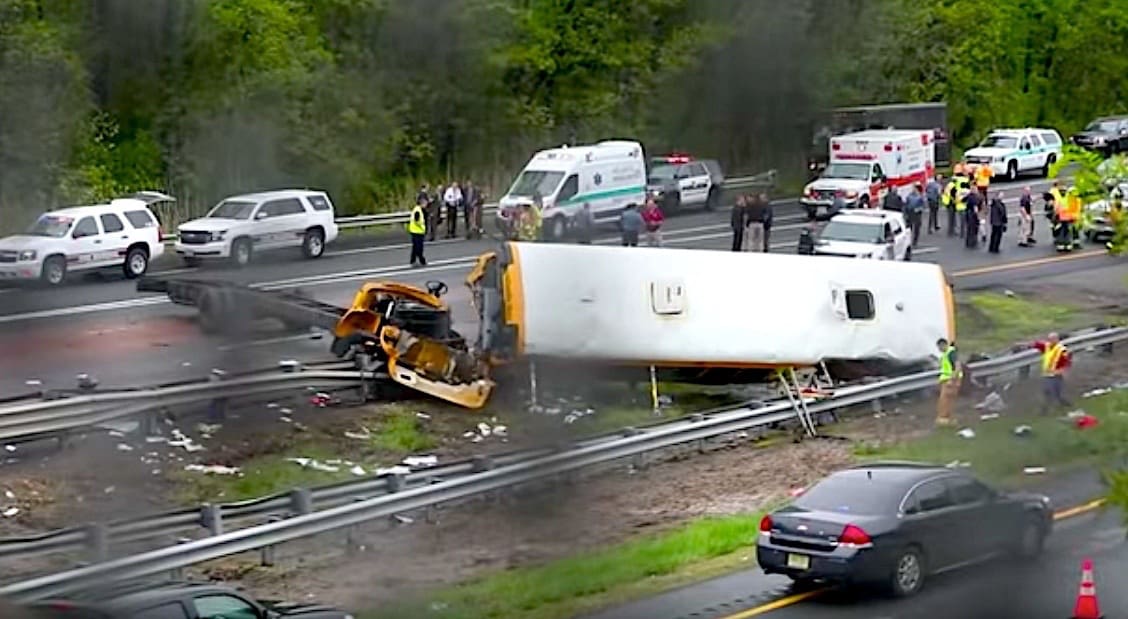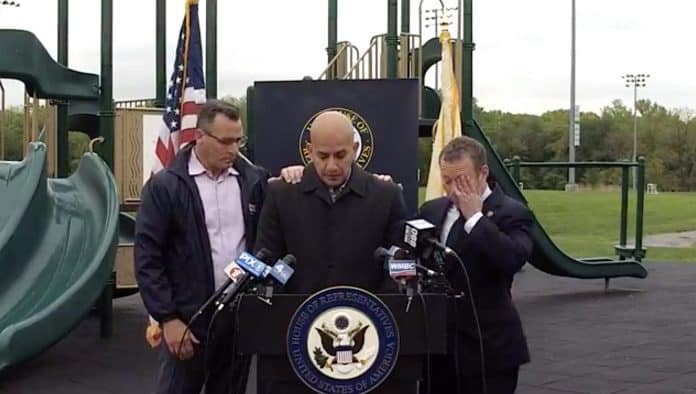Significant national legislation to require lap-and-shoulder seat belts on all school buses, plus real-time background checks on all school bus drivers, was reintroduced into Congress on May 14.
Then on May 22, the bipartisan Secure Every Child Under the Right Equipment Standards (SECURES Act) was formally introduced in the House of Representatives. It is co-sponsored by Reps. Josh Gottheimer of New Jersey and Elise Stefanik and Tom Reed, both of New York.
On the same day, the bipartisan Miranda Vargas School Bus Driver Red Flag Act (Miranda’s Law) was formally introduced in the House, co-sponsored by Gottheimer, Stefanik, Reed, Steve Cohen of Tennessee, Dan Kildee of Michigan, Elijah Cummings of Maryland, Albio Sires of New Jersey and Thomas Suozzi of New York.
Gottheimer noted, “The lap belt is a relic of the past. Like any parent would, I want to ensure all of our children, regardless of where they live, are as safe as possible on our school buses.”
Reed added, “Why wouldn’t we require every school bus to have them installed? This is only fair for the parents of millions of school-age children who worry daily about their child’s safety every day as they head off to school.”
Gottheimer announced a new campaign on May 14 to pass bipartisan national bus safety legislation to protect children on school buses nationwide. It encompasses the Miranda Vargas School Bus Driver Red Flag Act (Miranda’s Law) and the Secure Every Child Under the Right Equipment Standards (SECURES) Act.
At an emotional press conference on May 14, Gottheimer stood alongside Joevanny Vargas, the father of Miranda Vargas, who died when her Paramus School Board bus crashed during a field trip on May 17, 2018. The elder Vargas will be joining Gottheimer in Washington, D.C., this spring to tell his story on Capitol Hill to help secure congressional support.
The bipartisan SECURES Act would require seat belts on all school buses and makes three-point lap-and-shoulder seat belts the national standard. It also would encourage innovative measures to ensure students actually wear their seat belts while on school buses.
The bipartisan Miranda’s Law is also cosponsored by Stefanik and Reed, along with Reps. Steve Cohen of Tennessee, Dan Kildee of Michigan, Elijah Cummings of Marland, Albio Sires of New Jersey and Thomas Suozzi of New York. [This post continues after the photo and links below.]

Miranda’s Law ensures real-time background checks, so that when a school bus driver has any driving infraction beyond a parking ticket, the school district or school bus company will receive an alert about that infraction from the U.S. Department of Transportation within 24 hours.
“We are here to help turn tragedy into hope for other children and families. Joevanny will be joining me in Washington beginning this spring so that he can tell his story to members of Congress on why our communities so desperately need this bipartisan legislation,” said Gottheimer. “Miranda’s Law, and the SECURES Act, will help save lives. And there’s nothing partisan about that.”
Miranda’s father asserted that “This is not a New Jersey problem. This is a national problem that needs to be addressed before we’re confronted with another tragedy,” said Joevanny Vargas. “This is common-sense legislation—it’s not about Republicans or Democrats. It’s about moms and dads.”
Miranda’s Father Discusses Crash and Next Steps
“We are determined to make sure that these things don’t happen again,” Vargas commented. “[Miranda was] such a beautiful child. She was beautiful in and out. Miranda was always happy, smiling and playing with slime. She could never get enough of us. She would hug us so much, that I would have to remind her of my back problems.”
Vargas added, “We always talked about her future. … We will not see her eighth-grade graduation. … Her high school graduation. Her college graduation. I will not walk her down the aisle. I will never forgive anyone responsible for doing this to my baby. Everything around us reminds us of her.”
Miranda was only 10 years old.
“We lost her to a selfish, reckless, cowardly act by the school bus driver. … In this egregious accident, our community also lost Miss Williamson, who was a teacher at Eastbrook Middle School. She was loved, and she will be missed,” Vargas added.
Teacher Jennifer Williamson also died when the school bus driver inexplicably crossed multiple lanes of traffic on Route 80 and the vehicle was struck by a dump truck.
Vargas also explained that “I would ask myself why? … This would have never happened, yet the driver was clearly at fault. But why was he driving this bus, filled with children and teachers? At the time, he was 77 years old and had 14 driver suspensions—one just before the accident, in December 2017. Who allows this to happen?”
Vargas continued to discuss the bus driver and question why he was allowed to drive a school bus. “Again, this could have been avoided. How could you not monitor who drives our precious children to and from school?”
Gottheimer’s full remarks at the May 14 press conference:
“I’m honored, humbled, and moved to be standing here with my friend, Joevanny Vargas. As we all know, Joevanny and his family have been through something no family should ever have to go through. The horrific tragedy that took Joevanny’s daughter, Miranda, changed the Vargas family forever. I don’t know how he or his wife get up every day, but as Joevanny has told me, he just has to put one foot in front of the other—for his daughter Madison, for the community, and, ultimately for Miranda’s legacy.
We also remember Jennifer Williamson, a wonderful, caring teacher on the bus that morning, who was also tragically taken from this community and from her family. I was so glad to see that a beautiful memorial was recently dedicated to Jennifer and Miranda in Besen Park in Paramus this past week.
I’m here this morning not only as your Congressman, but also as a parent of two public school children.
While it still pains Paramus and so many of us—we are here to help turn tragedy into hope for other children and families. I hope that no one will have to live through what the Vargas and Williamson families have had live through this past year. That’s why, this week, I am reintroducing Miranda’s Law and the SECURES Act, bipartisan legislation to protect our children on America’s school buses.
Joevanny and I are also announcing a new campaign, of sorts, beginning on Capitol Hill, to help get this legislation across the finish the line. We are partnering up. Joevanny will be joining me in Washington beginning this spring, so that he can tell his story to the members of the Transportation and Infrastructure Committee, and other members of Congress, of why our communities so desperately need this bipartisan legislation.
We made great strides last year. Working together with many state and local officials, including Senators Lagana and Sarlo, Assemblyman Tully, and Assemblywoman Swain, spurred by the Vargas family, we were able to implement life-saving changes on school buses here in New Jersey, including three-point-seat-belts on new buses and better driver background checks. Now, it’s time for every child, in every state, to have those same protections on their way to school or a field trip.
Like everyone here, I remember that Mayday like it was yesterday. Only hours after the tragedy, one parent called me and asked if the bus had seat belts and if the children were wearing them. I immediately checked with the school and I was told that indeed the children were buckled up, with lap belts, as required by New Jersey law.
In fact, at the time, New Jersey was only one of eight states in the country where large school buses must have lap belts, not three points, lap-and-shoulder seat belts like every car and truck is required by law—and for good reason.
It was shocking to me that only eight states require any type of seat belts, put aside the kind of seat belt. Every day, nearly 600,000 school buses carry more than 25 million students to and from school, activities, and class trips. We don’t allow our children to ride without their seat belts when they’re in our cars. Yet, in buses they could?
From 2000 to 2014, GAO found there was an average of 115 fatal crashes involving school buses each year. Why would we allow them to ride without a seatbelt on a bus?
Like any parent would, I wanted to know if more could be done to ensure that all of our children, regardless of where they live, are as safe as possible on our school buses.
From there, our team went to work, and our research showed us that, one, the evidence couldn’t be clearer—seat belts in school buses save lives. And, two, that as a country, there was much more we could do.
In the National Transportation Safety Board’s (NTSB) report on a fatal 2016 rollover bus crash in Chattanooga, Tennessee, that killed six young children, they found that the lack of three-point belts contributed to the severity of the crash.
In a 2014 bus crash in Anaheim, California, nine students and the driver were injured, and thankfully no one was killed. This was the first crash in the nation involving a school bus that was equipped with three-point belts in all seating positions, as required by California law. The NTSB looked at what might have happened if the two most seriously injured students were wearing only lap belts and found that the outcome would have been much worse.
That’s why this week, I’m reintroducing the bipartisan Secure Every Child Under the Right Equipment Standards Act—or SECURES Act. This legislation, cosponsored by Elise Stefanik and Tom Reed, a bipartisan bill, the SECURES Act of 2019, has three central components.
The SECURES Act requires seat belts on all school buses. Current federal law only requires seat belts on small school buses, not the larger ones that our children often ride on. Only eight states, including New Jersey now, require them on those bigger buses.
The SECURES Act will also make three-point lap-and-shoulder seat belts the national standard, just like we have in our cars. The lap belt is a relic of the past. Why don’t we require our children to wear them?
According to the NTSB’s formal recommendations, “Properly worn lap-and-shoulder belts provide the highest level of protection for school bus passengers in all crash scenarios, including frontal, side, and rear impacts—and rollovers.” Research shows that while school bus designs are generally effective in protecting occupants in frontal- and rear-impact crashes; they are less effective in protecting from side-impact or rollover crashes, like Miranda’s bus.
In the aftermath of the tragic crash, we’ve also updated our standards in New Jersey to require three-point seat belts. But we need to bring this nationwide. The SECURES Act will do just that.
The SECURES Act will also encourage innovative measures to ensure that students are actually wearing their seat belts while on school buses.
Three-point seat belts are effective in protecting kids during a crash only if they are being worn properly. That’s why my bill also spurs the DOT to consider any innovative approaches to seat belt detection, seat belt reminder systems, and seat belt violation alert systems that could be incorporated into school bus designs.
It works to harness the power of technology and innovation—which for so long have remained untapped when it comes to school bus safety—to secure our kids. In my own car, if the passenger hasn’t buckled up, it alerts me. Why can’t we have alerts on a bus when a child isn’t wearing a seat belt?
In this day and age, my credit card company alerts me within seconds if there’s a suspicious charge on my account. Our cars have lane-changing alerts and even airbags on our seatbelts. Yet, when we have an app for everything, when I look at the school buses transporting my kids, they look no different than the ones I rode when I was their age. That’s unacceptable.
The other significant and bipartisan legislative step we are announcing today, Miranda’s Law, takes on the other safety roadblock we have to overcome nationwide—unsafe and unfit school bus drivers, like the one driving Miranda’s bus that day. As you know, 99 percent of school bus drivers are trained and qualified. They are good people who work hard and watch after our children like their own.
But not Miranda’s. Hudy Muldrow was 77-years-old at the time and had more than 14 license suspensions. He’s been indicted on two counts of reckless vehicular homicide and forty-one counts of assault by auto.
We must strengthen background checks on drivers to protect our children from those, like Mr. Muldrow, who has no place getting behind the wheel of a school bus. Miranda’s Law will make sure that when a school bus driver has any driving infraction beyond a parking ticket, the school or school bus company will receive an alert about that infraction from the Department of Transportation within 24 hours.
Right now, a bus driver can get a license and then go months without their employers receiving updates on their background. Under current federal regulations, employers of school bus drivers are required to check their employees’ driving history records only annually. So, if a driver fails to self-report a DUI, reckless driving, or a license suspension, it could be up to 364 days before a school district or motor carrier obtains that information. Yes, 364 days that the school bus driver is behind the wheel with our children.
Research has shown that only 50 to 80 percent of commercial drivers, including school bus drivers, actually self-report violations. That’s an unacceptable safety risk, because suspended drivers have a crash rate 14 times higher than other drivers.
NTSB found a lack of driver oversight to have caused that fatal bus crash in Chattanooga. As for the Paramus crash, I am glad that the driver is being brought to justice, but this should never be able to happen ever again. If you have your license suspended 14 times, you should not be driving schoolchildren.
Here is another stunning fact: according to CBS News, on average, across the nation, at least once a week, a school bus driver is arrested for charges as serious as driving under the influence.
In 2013, New Jersey drivers with up to 64 license suspensions and multiple DUI convictions were able to get licenses to operate school buses. These are the kinds of drivers who make illegal U-turns in the middle of busy highways. No parent should have to worry that their child’s school bus driver has DUIs or a history of dangerous and reckless driving.
Miranda’s Law will make sure that schools see red flags in real-time—within 24 hours—to help remove dangerous school bus drivers from the road—immediately. It will require real-time, automatic notifications of driver violations to school districts and other employers of school bus drivers, so they can take immediate action to keep unsafe drivers off the road.
This way, school districts and school bus companies won’t be left in the dark, when it comes to the driving qualifications of their employees. I’ve also signed onto the Stop for School Bus Act, which will help prevent illegal passing of school buses.
Miranda’s Law, and the SECURES Act, will save lives. And there’s nothing partisan about that. It’s not a Democratic or Republican issue. It’s a mom and dad issue. And, speaking of bipartisanship, I want to thank my Republican co-sponsors of both these pieces of legislation, Elise Stefanik and Tom Reed—both of New York. In addition, Congressmen Cohen, Kildee, Cummings, Sires and Suozzi, have signed on to cosponsor Miranda’s Law. It’s great when our region can come together to take real action to get things done for our communities.
Today, we honor the lives of Miranda Vargas and Jennifer Williamson, and pray for their families, and we recommit ourselves to doing everything we can to make sure our kids are as safe as they can be. We live in the greatest country in the world, and if we are to ensure that our best days will always be ahead of us, we have to protect our children—our future.”
- Related: Ala. Bill Extends School Bus Stop Arm Enforcement Statewide
- Related: AISD School Bus Stop-Arm Violations Top 1,000
- Related: Extended School Bus Stop Arm Decreases Illegal Passing
- Related: FMCSA Updates on Minimum Driver Training, Drug Testing
- Related: Miranda’s Law Formally Introduced in U.S. Congress
- Related: New Jersey Gov. Murphy Signs School Bus Safety Legislation
- Related: New Jersey Gov. Murphy Signs Three School Bus Bills
- Related: New School Bus Safety Legislation Formally Introduced in Congress
- Related: New York State School Bus Safety Legislation Advances
- Related: N.J. School Bus Driver Given Narcan After Alleged Overdose, Crash
- Related: NYSBCA Calls on Legislature to Increase Fines for Illegal School Bus Passing
- Related: N.Y. Budget Includes School Bus Funding, Not Stop Arm Video
- Related: N.Y. School Bus Contractors Call for Bus Safety Legislation
- Related: N.Y. Tightens Drug, Alcohol Testing Rules for School Bus Drivers
- Related: School Bus Safety Efforts are More Than Just Requiring Seat Belts
- Related: School Bus Safety Legislation Introduced
- Related: School Bus Safety Legislation Moves to Indiana Governor’s Desk
- Related: School Bus Stop-Arm Cameras Unfair, Dallas Motorists Say
- Related: Stronger Penalties Proposed in Indiana School Bus Safety Legislation
- Related: Texas Bill Would Prohibit School Bus Stop-Arm Cameras
- Related: Two Students Struck After High School Student Illegally Passes School Bus
- Related: Virginia School Bus Stop-Arm Camera Bill Signed into Law
















